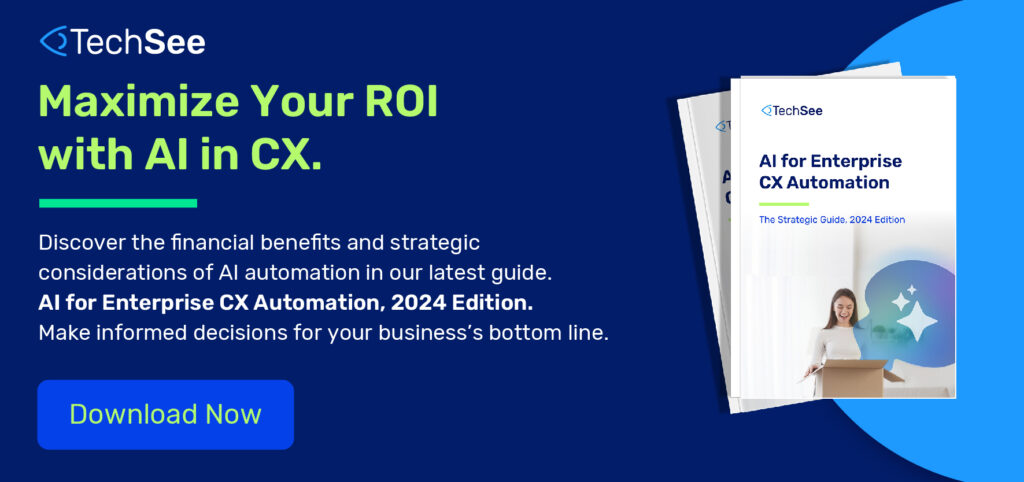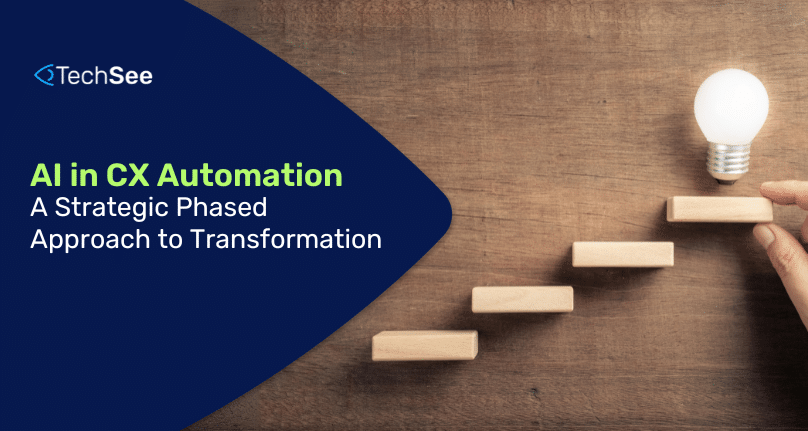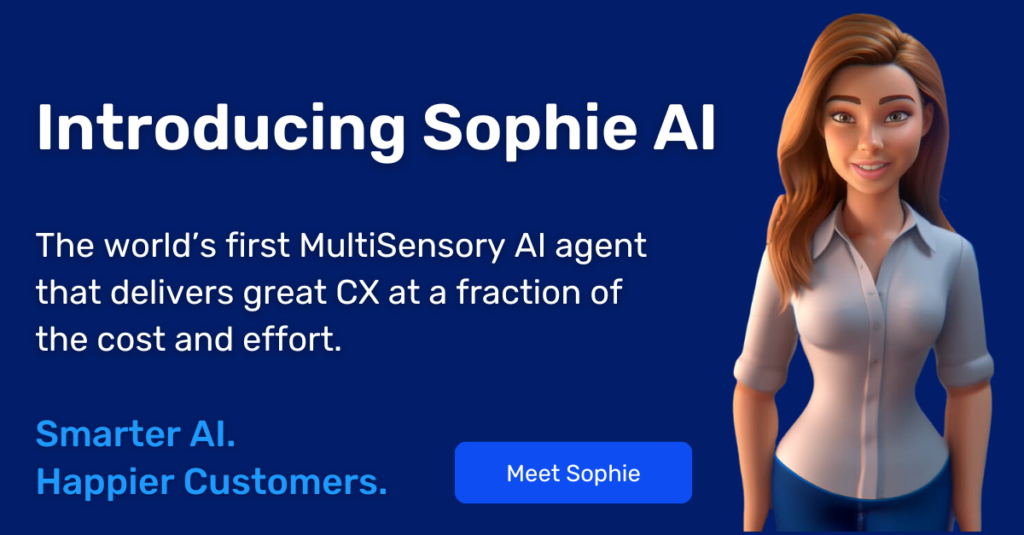Contents
Enterprise leaders are constantly seeking innovative ways to improve their customer experience (CX), ideally while improving their bottom line. Generative AI is more than the hot trend of the year; it has the potential to improve and automate CX. However, the cost of AI talent, AI training, tuning, and refinement, as well as LLM consumption-based tokens at scale, begs the question, is Generative AI in CX a financially sound endeavor? What is the ROI of Generative AI in CX?
The Costs of Generative AI-Powered Automation
Implementing generative AI-powered automation in CX involves several costs, all of which must be taken into consideration to determine or project the ROI of Generative AI.
- First, there’s the initial investment in the technology itself, which can be substantial. This includes the cost of the AI software, hardware, and potentially cloud infrastructure.
- Next, businesses must invest in training and development. Generative AI models require large amounts of data to learn from, and preparing this data can be time-consuming and expensive. The models must also be trained, which requires computational resources and expertise.
- Furthermore, one must consider the cost of hiring, training, and retaining top-tier AI talent that will train the AI, optimize performance, and, ideally, optimize usage-based or runtime costs.
- Now that the initial AI setup is complete, the AI must be thoroughly tested and optimized before any scaled rollout.
- Possibly the most expensive investment is the cost of AI runtime, typically measured in tokens, seats, or a usage-based license.
- Finally, there’s the ongoing cost of maintenance and reporting. Like any technology, generative AI systems need to be monitored, optimized, maintained, and updated to ensure they continue to perform optimally. This includes monitoring the system, fixing bugs, and retraining the model as new data becomes available.
Common Pitfalls of Generative AI-Powered Automation
While generative AI holds great promise, businesses should be aware of several common pitfalls. One is the risk of over-reliance on automation. While AI can handle many tasks efficiently, there are still areas where human intervention is necessary. Over-automating can lead to a depersonalized customer experience and potential customer dissatisfaction.
Another common pitfall is the lack of training and transparency. Generative AI models, especially deep learning models, are often referred to as “black boxes” because their decision-making processes are not easily interpretable. This lack of transparency can make troubleshooting and optimization a challenge. Furthermore, poor real-world performance will lead to mistrust among customers, especially if the AI makes a mistake.
Possibly, the most common pitfall is a lack of strategic planning and program oversight. AI automation is not a zero-sum game and can be started with a smaller, lighter deployment in a phased rollout. However, betting the future on a single provider without a practical understanding of the challenges, limitations, costs, leadership buy-in, and staffing required to facilitate the long-term objectives is unlikely to yield the desired impact.
The Financial Upside to CX Automation Made Possible by Generative AI
Despite these challenges, the financial benefits of implementing generative AI in CX are significant. We will start with an understanding of the lagging indicators (the bottom line impact), followed by an overview of the leading indicators, signals of future ROI.
The ROI of Generative AI in CX: Lagging Indicators
- Cost Savings: AI-Augmented CX
The first step towards AI-powered CX Automation in most enterprises is developing and rolling out AI-powered CX augmentation. For example, customers waiting on hold (for an agent) can be sent an information collection flow. When customers provide images of their receipt or product, computer vision AI can fairly easily identify the customer, product, and even their particular issue. Providing this information to the customer service representatives accelerates their average handle time while improving the customer experience. Best of all, there is virtually no AI risk exposure to the enterprise. Every minute agents spend on the phone with customers costs anywhere from 30 cents to a dollar.Similarly, AI Assistants and CoPilots can help Tier 1 agents better support customers. While the more basic, first-generation CoPilots can provide sample responses, product knowledge, and automated service summaries, second-generation AI Assistants can perform actions in third-party systems on behalf of the agents, and the latest third-generation AI Assistants can visually identify specific products, diagnose issues, and guide agents through step-by-step support flows. With each subsequent generation of technology, AI Assistants become increasingly capable, shaving costly time off these customer interactions. Every minute is saved in AHT compounds to generate substantial cost savings while improving the customer’s experience and lifetime value. - Cost Savings: AI-Automated CX
While not all CX interactions can or should be fully automated, AI is increasingly able to automate many common customer issues. When customers are able to resolve their own issues better, customer service representatives are freed to focus on more complex tasks, improving overall productivity and substantially reducing overhead.For example, most customers call their security company or telecom provider for two reasons. Typically, they either (a) are calling with an account/billing inquiries, or (b) are trying to troubleshoot a service outage. The same cognitive and integrated AI solutions that can automate account/billing issue research for agents, can be used to automate the entire customer experience. Similarly, the same multisensory service flows (and the integrated logic flows) that guide Tier 1 agents can be used to guide end-customers. By automating many of these repetitive service inquiries, CX leaders can improve service response and handle times, reduce their overhead, and free human agents to focus on customers who most need human support.As with all new technology and operational changes, the full transition to autonomous CX will likely be gradual. As a first step, most enterprises are first testing and proving their AI automation internally, with a smaller pool of test users. With success, the pool of internal users grows. Once the AI automation has been thoroughly vetted and proven internally, the technology can be strategically rolled out to end customers. Initially, this will likely be limited to a subset of customers and a subset of issues, with the AI automation’s scope expanding as the technology solutions are verified as effective. Typically, AI-automated customer interactions will be semi-autonomous, with a human expert monitoring the AI to ensure service quality. However, even at this early stage, there is a clear ROI. A single human agent can readily monitor multiple concurrent AI interaction transcripts. However, a phone agent can only support one customer at a time. These efficiency gains must be measured and reported in order to garner further executive or board investment. - Revenue Generation: New Revenue Streams
AI-automated CX presents a wealth of opportunities for entirely new revenue streams. In some industries, customers may be open to paying for a subscription to a 24/7/365 AI-automated or AI-augmented service package. In other industries, AI automated service will be the standard offering – with human agent-based support offered only to premium customers or subscribers. No matter how you slice it, premium services are a potential revenue-generating angle for any service leader.Great CX doesn’t live and die in the service domain. Generative AI can be used to automate upsells, renewals and expansion. While the low-hanging fruit will be more traditional Generative AI-powered email messaging, innovators will look to this technology to deliver uniquely compelling experiences that more effectively convert customers across multiple touchpoints.Furthermore, as digital-native interactions, Generative AI customer interactions can be mined to discover new product or service opportunities. Generative AI customer interactions, particularly when combined with the rich user data of internet-connected hardware or services, is a veritable goldmine. Deeper understanding of customer needs and desires can yield substantial new lines of revenue for the enterprise. - Revenue Generation: Customer Lifetime Value
Any substantial improvement to the customer experience should have an attributable impact on customer LTV. Happy customers are loyal customers. If your customer sales cycle is short enough, you should be able to demonstrate the causational impact of improved CX on customer LTV. If you cannot show causational impact, look for correlational trends that demonstrate the positive LTV impact of your Generative AI investments in CX Automation.Naturally, some industries have longer sales cycles (e.g., enterprise software, automotive purchases), and cannot demonstrate causational growth within a reasonable period. Consider focusing more on your leading than lagging indicators for these industries.
The ROI of Generative AI in CX: Leading Indicators
As a future-facing investment, it is often critical that CX leaders building Generative AI automation consider their leading indicators or “soft” ROI metrics. Below are a few examples of leading indicators of future ROI impact, though there are likely more.
- Customer Satisfaction
Customer Satisfaction, also known as CSAT, is a popular CX metric that measures how happy or satisfied customers are at a given stage in their journey. Multiple studies demonstrate the correlation of CSAT improvements to customer LTV. Nevertheless, some enterprises prefer to measure CSAT as a leading indicator of potential revenue rather than a hard ROI metric. Regardless of how your organization prefers to view CSAT, attributing the improvements made possible by Generative AI automation is critical to showing the long-term potential of this investment. - Net Promoter Score: Your Viralality Coefficient
Net Promoter Score (NPS) is similar to CSAT, in that it measures the overall customer’s impression of their experience, but not identical. CSAT asks customers how satisfied they are with their experience. In light of your recent interaction, NPS asks, how likely are you to recommend this product or service? Like CSAT, organizations are split as to whether to view NPS as a leading indicator, or lagging indicator. Again, like CSAT, NPS improvements made possible by Generative AI automation is critical to showing the long-term potential of this investment. However, when reporting the NPS impact of your Generative AI investments, be sure to note the brand value inherent in the NPS metric. Customers who self-report as likely to recommend your product or service are more likely to be brand advocates on social media; both online and in the real world. - Customer Effort Score
As the name implies, Customer Effort Score (CES) measures how much effort customers consider an interaction to have exhausted. Often presented on a scale of 1-3, CES is used to understand how hard customers find interacting with your business to be. The higher the CES score, the more likely customers will be to churn. When CX automation meaningfully reduces CES, particularly in CX interactions where there was previously a high CES, there is a demonstrable CX impact that should be recorded and reported. While CES improvements may not be viewed as the bottom-line impact on a balance sheet, this should serve as a rationale for further investment in this promising technology. - Learnings and Capability Development
As a new and promising technology, Generative AI should not be viewed as a question of If but When and How. As such, any programs that enhance the organization’s understanding of this new technology, skillset, and readiness for future deployments of this technology should be reported. For example, even if the first deployment doesn’t deliver the desired bottom-line ROI impact, this experience should help to inform and shape future Generative AI and CX initiatives.
Conclusion
While the journey to implement generative AI in CX comes with its costs and risks, the potential financial upside is undeniable. By understanding these factors, businesses can make informed decisions and strategically invest in this promising technology.
To learn more about Sophie AI and how we can deliver real-world ROI for your organization, please contact us today.








